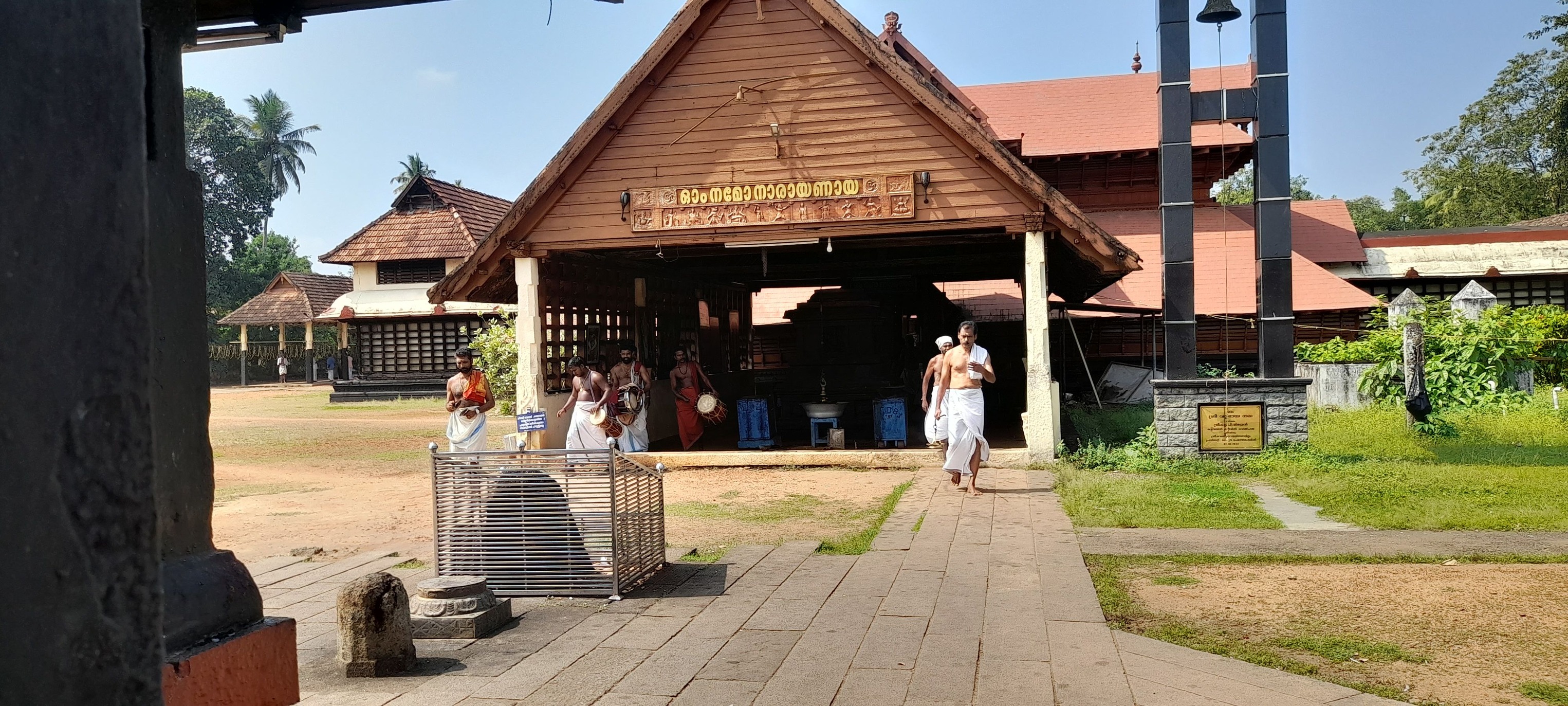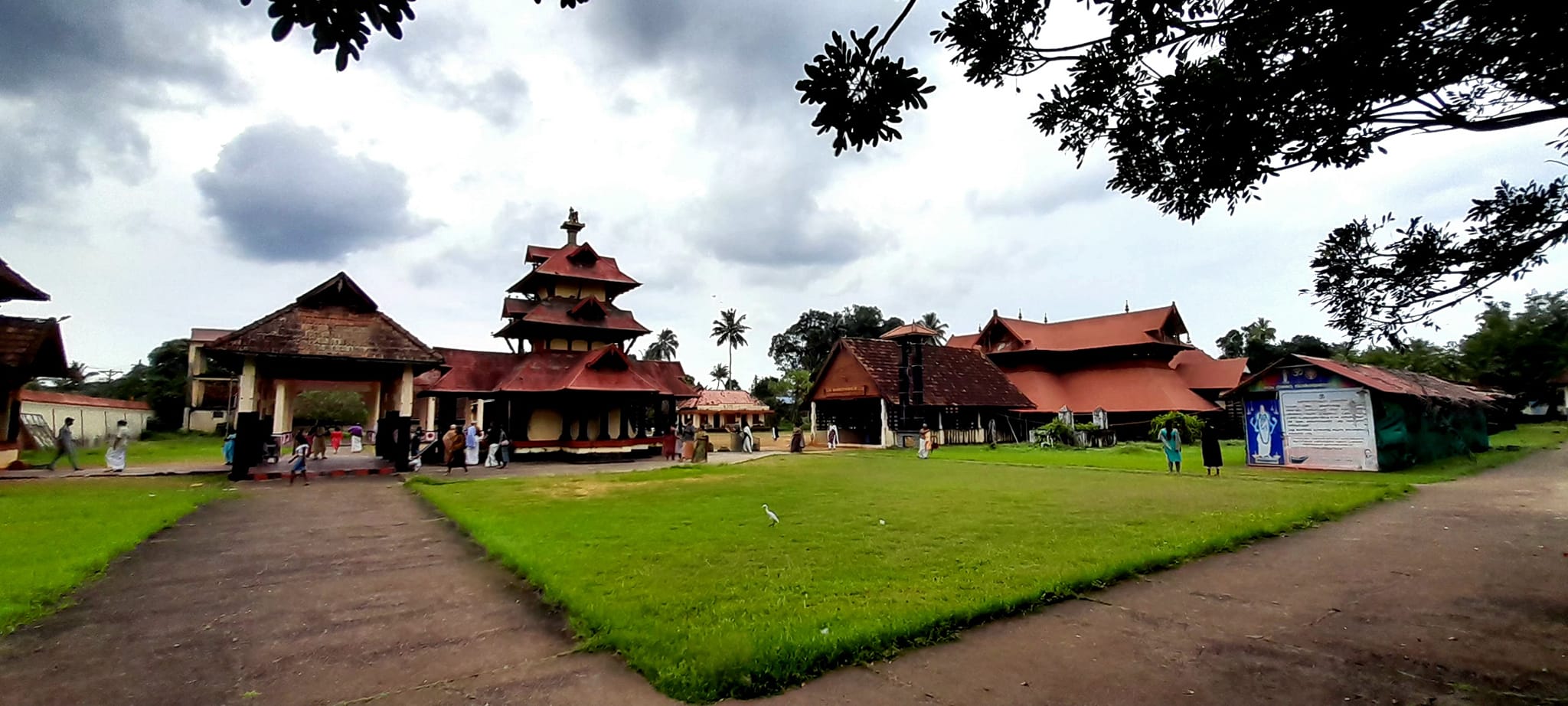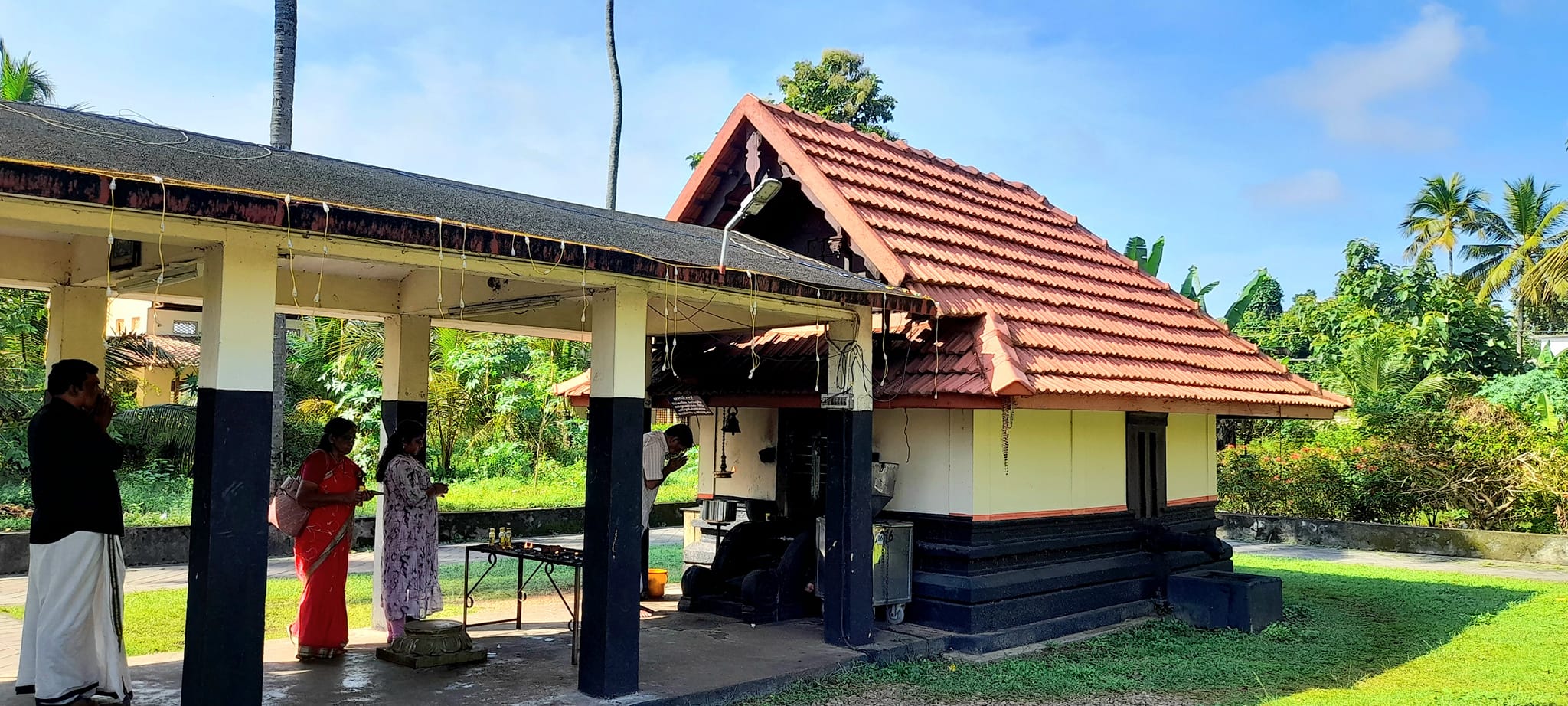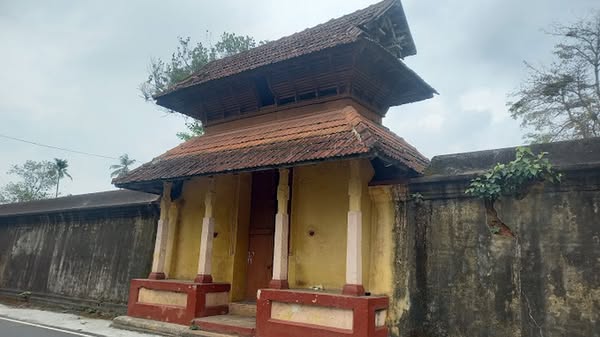Sreevallabha Temple, situated in the city of Thiruvalla in Pathanamthitta, is among the oldest and largest temples in Kerala, as well as one of the 108 Divya Desams. This orthodox Hindu temple is dedicated to Sreevallabha, a manifestation of Vishnu.

It has been esteemed by the Alvars and is reportedly referenced in the Garuda and Matsya Puranas.
According to tradition, Vishnu manifested here as Sreevallabha for the sage Durvasa and Khandakarnan. Sreevallabha, responding to the prayers of an elderly Brahmin woman, incarnated as a Brahmachari and vanquished the demon Thokalaasuran.
The idol of Sreevallabha, revered by Lakshmi and Krishna, was enshrined in the temple, where it is said that Durvasa and the Saptarishi visit every midnight. The temple is renowned for its architectural beauty and distinctive customs, with daily performances of Kathakali. It has played a significant role in the cultural and educational advancement of Kerala.
The temple, overseen by the Travancore Devaswom Board, stands as a prominent structure within the Thiruvalla group. Situated along the banks of the Manimala River, it spans an area of 8.5 acres, making it the largest temple in the Travancore region. The temple is encased by red-granite walls that rise 12 feet high, extend 566 feet in length, and measure 4.5 feet in thickness, featuring a two-story gopuram (entrance tower) on each side. These walls were constructed in 57 BC.
Adjacent to the eastern wall lies a 1.5-acre pond, which is marked by a copper flagstaff on its southern bank. In front of the eastern entrance, there is a platform designated for Kathakali performances. Within the confines of the wall, a walking path is available. Uniquely, the dining hall is located in the southeast corner, contrasting with the typical placement of dining halls in the northern section of other temples. The temple's auditorium and administrative offices are situated nearby.
Smaller shrines dedicated to Ganapathy and Ayyappan, along with an additional auditorium, are located on the south-western side of the complex. The temple guard, situated on the north side of the other temples, is positioned to the south. Near the Ayyappan shrine, one can find the sacred fig and mango trees where Durvasa once meditated. The Sankaramangalth Illam, the residence of Lalithambika Antharjanam, is located outside the western tower. The north gopuram is exclusively opened during the Uthra Sreebali festival. A pond, fed by a spring and utilized by the priests, is found in the north-eastern area.
It is noted that Vedavyasa and Durvasa vanished from the eastern bank of this pond, while a building for the priests is situated to the south. To the north of the temple, there exists an open-air shrine. It is important to mention that the temple stage was destroyed by fire in 1915. The Garuda flagstaff, constructed from black granite, rises to a height of 53.5 feet and dates back to 57 BC; its base extends down to the water table. Atop the flagstaff is a three-foot statue of Garuda, oriented towards the temple.
The structure has begun to lean and is encased in a three-tiered support system. Adjacent to it, to the west, stands a golden flagstaff.
To the west of the third flagstaff, there is a two-story building with a copper roof, upheld by 16 stone pillars. This building houses a ten-foot-high altar, which serves as the main sacrificial stone. The pillars and roof are adorned with intricate carvings, while the western section features murals and a small shrine. A central corridor connects to a 150-foot-long and 11-foot-wide edifice, constructed from black stones and supported by 54 stone pillars, each intricately carved with a salabhanjika.
The sreekovil, characterized by its round structure, copper roof, and golden dome, features intricately etched murals depicting various deities, including Matsya, Kurma, Dakshinamurthy, Varaha, Ganapathy, Narasimha, Vamana, Sudarshana, Parashurama, Rama, Purusha Sukta, Balarama, Krishna, Lakshmi, Kalki, and Garuda. The outer circumference of the sreekovil measures 160 feet and is composed of three concentric walls. The statue of Sreevallabha, which stands seven feet tall and is elevated to a height of 10 feet, depicts him holding a lotus in his right hand, while the Sudarshana Chakra is positioned in his right upper hand, with his left hand resting on his waist.
Khandakarnan and His Bells :
Although Khandakarnan was the offspring of Shiva, he was a demon who engaged in the sacrifice of animals to gain his father's favor and consistently sought to belittle Vishnu. He adorned himself with a pair of bells as earrings, which allowed him to hear only the name of Shiva, a name he incessantly chanted. When he failed to attain salvation, he inquired of Shiva the reason for this. Recognizing the equal power of both Shiva and Vishnu, Shiva counseled him to devote himself to Vishnu. Following the guidance of Durvasa, Khandakarnan journeyed to the jasmine forest, where he immersed himself in the Jalavanthy pond. The sacred waters purified him of his misdeeds. Subsequently, he discarded his Shaiva earrings and replaced them with Vaishnava earrings, enabling him to hear only the name of Vishnu. In the Dvapara Yuga, Vishnu manifested before him, granting him liberation.
Journey of Sreevallabhan’s Idol :
Following the establishment of Dvaraka, Sagara presented numerous valuable items, including the idol of Sreevallabhan, to Krishna. Krishna entrusted this idol to his companion, Satyaki, stating, "There is no offering more esteemed for the veneration of Vishnu than the idol of Sreevallabhan. The act of worshipping Vishnu directly is equivalent to honoring this idol, which possesses the ability to cleanse the sins accumulated over countless lifetimes.
Satyaki sought Krishna's approval to construct a temple, which was subsequently designed by the divine architect Vishvakarma in Dvaraka. The sage Vedavyasa performed the installation of the idol, while Durvasa instructed the priests on the proper rituals for worship. As the Dvapara Yuga drew to a close, Satyaki entrusted the idol to Garuda, requesting him to safeguard it for humanity during the Kali Yuga. Garuda traveled to the island of Ramanaka, where he worshipped the idol, which liberated him from his afflictions.
When the time came for Garuda to return to Vaikuntha, he concealed the idol in the depths of the Netravati River, located in the present-day Dakshina Kannada district of Karnataka. Thukalasuran and Yakshi
Mallikavanam faced an assault from Thukalasuran, a demon notorious for his penchant for stealing and consuming the flesh of young humans. A yakshini emerged along the western road leading to the village, attacking all who crossed her path. As a result, many residents abandoned Mallikavanam, which became inaccessible to visitors.
The elderly Antharjanam was unable to leave, and it proved challenging to find a Brahmin boy to fulfill her religious obligations. In her despair, she prayed before her Vishnu idol, pleading for the preservation of the customs she had adhered to for many years. A young Brahmin boy, holding a golden pole, approached her seeking food. Overjoyed to see him, Antharjanam invited him to return after his bath, as she needed assistance with the Ekadashi rituals. Ignoring her cautions, the young man ventured to the river where Thukalasuran resided. A battle ensued between them; the golden pole transformed into the Sudarshana Chakra, enabling him to vanquish Thukalasuran and his forces.
After cleansing himself in the river, the young man bound the yakshini and cast her into a well, where she met her demise. Subsequently, he established a Durga idol and implored the goddess to safeguard the town, leading to her manifestation in three local temples. The Installation of the Sudarshana Chakra
The boy, along with five companions, subsequently arrived at the Sankaramangalath House. Antharjanam performed the necessary rituals and provided them with food served on areca nut leaves, as the rakshasa had ravaged all the banana plantations. Lacking pickles, which are traditionally served to Brahmins, Lakshmi, in the guise of a housewife, offered thrippuli (a type of pickle) to the boy. Aware that Thukalasuran had been vanquished by the boy, the locals came to pay their respects and requested to see his golden pole for veneration. The boy erected the pole, oriented westward, on elevated ground to the east of their location. Antharjanam resolved to construct a temple at that site and appointed Pathillathil Pottimar as its administrator.
The boy then removed his shawl, revealing his chest adorned with the Srivatsa mark and Lakshmi; Vishnu manifested his universal form (Vishwarupa) to her family. Antharjanam, along with her servant and the servant's son, attained salvation by merging with him. This event took place in 2998 BC; the five boys accompanying Vishnu included the sage Durvasa and his disciples. The Sankaramangalath House is preserved outside the temple, adjacent to its western gate, and is regarded as the original temple.
Installation of Sreevallabhan’s Idol :
Approximately 3,000 years later, King Cheraman Perumal visited the temple. His consort, Queen Cherumdevi, expressed a desire to construct a shrine dedicated to Vishnu adjacent to the Sudarshana shrine. Following the temple's reconstruction, they commissioned a Vishnu idol from Tamil Nadu. The queen experienced a dream in which Garuda, appearing as a Brahmin, informed her about Sreevallabhan's idol and requested its installation at the site. With the assistance of Garuda and the Tulu Brahmins, Cheraman Perumal transported the idol from the Netravathi River to Chakrapuram for its installation.
During the installation ceremony, the idol did not fit the pedestal, prompting the priests to step outside. They then heard celestial music and the recitation of Vedic hymns emanating from within. Upon returning, they discovered the idol perfectly positioned, radiating light, with bananas placed on an Areca nut palm leaf before it. Durvasa and Vyasa emerged from the sanctum and vanished on the eastern bank of the Jalavanthy. The Sreevallabha Temple had been constructed by Uliyannoor Perumthachan, with the temple wall and flagstaff completed in a single day in 57 BC.
Prohibition of Women :
Following a woman's experience of salvation at the shrine, there was an increased interest among women in visiting the temple. A woman, captivated by the attractive idol, sought to enter the sanctum sanctorum to unite with Vishnu. In response, the temple authorities, after consulting astrological guidance, decided to prohibit women from entering the temple. However, they later consented to allow female visitors on two specific occasions each year: the Arudra Darshanam day in the month of Dhanu and the Vishu festival day in the month of Medam. This prohibition was ultimately rescinded in 1968.
Vilwamangalam and Nammalvar :
On an early morning, Vilwamangalam Swamiyar arrived at the temple while a kathakali dance troupe was performing. He was taken aback by the absence of the deity's presence. Upon reaching the outer enclosure, he noticed a young Brahmin observing the dance and recognized him as Vishnu. Vishnu then vanished into the temple, remarking that Swamiyar had interrupted his enjoyment of the dance he cherished. Following this incident, kathakali performances became a regular occurrence at the temple. Later, the Vaishnavite saint Nammalvar visited the temple in the evening and fell asleep.
In his dream, he beheld Vishnu manifesting as Padmanabha, reclining in the ocean of milk; the infant Krishna, who held the universe in his mouth; and Vamana, who requested three paces of land from the asura king Mahabali. At Sreevallabha Temple, the deity Vishnu is revered in his cosmic, primordial, and transcendental aspect (purusha). Within the sanctum sanctorum, the upper and lower parts of the idol remain obscured, symbolizing the infinite nature of purusha, which is without beginning or end. Adorning the deity in white or saffron signifies the eternal essence of purusha. The temple adheres to the distinctive Pancharaathra Vidhaanam tradition of worship, a practice that has remained consistent since 59 BC.
Five daily pujas are conducted. The deity is first awakened and bathed with sacred water. This is succeeded by a naivedyam (offering). The idol is then adorned in an 18-foot-long white mundu, resembling a brahmachari, accompanied by two flower garlands. Following the primary offering, the deity is dressed in a saffron-yellow mundu and adorned with a garland. At noon, the deity is venerated as a grihastha (householder). During the fifth puja in the evening, the deity is honored as Parabrahma and is attired in a saffron-colored mundu with a tulasi garland. After the sleeping ceremony, the sanctum sanctorum is sealed.
Sreevallabha Temple is recognized for its traditional practices. In 1997, poet and chief priest Vishnunarayanan Namboothiri was temporarily dismissed from his position after he traveled to Britain to participate in the Millennium Conference on Integration of Science and Consciousness, which was deemed a breach of temple customs. The chief priest is required to be at least 50 years old and married. Additionally, the priests may be rotated every three years. It is also prohibited for devotees to use sacred ash (vibhuti) within the temple premises.
Ritual Walk :
It is recommended to perform four clockwise circumambulations (Parikramas) within the temple: one outside and three within the temple premises. Enter through the eastern gate, proceed to the left, and offer your respects to Ganapathy, Shiva, and Ayyappan located on the southern side. After completing the circumambulation of the sacred fig and mango trees, make your way to Sankaramangalath Illam, which is situated outside the western gate. Upon returning to the temple, follow the northern circumambulation path. Pay homage to Kali at the northern gate. Next, visit Jalavanthy and offer your respects to Vedavyasa and Durvasa on the eastern bank.
Turn right to worship Garuda before entering the temple. Within the sanctum, pay homage to Sreevallabha, Lakshmi, Bhudevi, Varaha, and Dakshinamurthy through the eastern door, and to Sudarshana Chakra through the western door. The temple hosts two principal festivals. The first, lasting for ten days, occurs in the month of Kumbham according to the Malayalam calendar (February–March). The second, known as Uthra Sreebali, is the temple's most significant celebration and takes place in the Malayalam month of Minam (March–April).
This festival honors three goddesses. On the eighth day, prior to their sacred bath, the goddesses make their way to Sreevallabha Temple. During this time, Ashtapadi hymns are performed, accompanied by dancing amidst lamps. Additional festivals include Vishu (mid-April) and celebrations during the months of Kaṟkkaṭakam (July–August), Cinnam (August–September), Tulam (October–November), Vr̥ścikam (November–December), and Dhanu (December–January). The temple hosts two principal festivals. The first, lasting for ten days, occurs in the month of Kumbham according to the Malayalam calendar (February–March).
The second, known as Uthra Sreebali, is the temple's most significant celebration and takes place in the Malayalam month of Minam (March–April). This festival honors three goddesses. On the eighth day, prior to their sacred bath, the goddesses make their way to Sreevallabha Temple. During this time, Ashtapadi hymns are performed, accompanied by dancing amidst lamps. Additional festivals include Vishu (mid-April) and celebrations during the months of Kaṟkkaṭakam (July–August), Cinnam (August–September), Tulam (October–November), Vr̥ścikam (November–December), and Dhanu (December–January).
ശ്രീ വല്ലഭ ക്ഷേത്രം, തിരുവല്ല
തിരുവല്ല പട്ടണത്തിൽ സ്ഥിതിചെയ്യുന്ന ശ്രീവല്ലഭമഹാക്ഷേത്രം പത്തനംതിട്ട ജില്ലയിൽ സ്ഥിതിചെയ്യുന്നു. ക്രി.മു. 59-ആം ആണ്ടിൽ സ്ഥാപിതമായ ഈ ക്ഷേത്രം കേരളത്തിലെ ഏറ്റവും പഴക്കമുള്ളതും, വിശാലമായതും ആയ ആരാധനാലയങ്ങളിൽ ഒന്നാണ്. ഇവിടെ മഹാവിഷ്ണുവും സുദർശനമൂർത്തിയുമാണ് പ്രധാന പ്രതിഷ്ഠകൾ. മഹാവിഷ്ണുവിനെ "ശ്രീവല്ലഭൻ" എന്ന പേരിൽ അറിയപ്പെടുന്നു, ഇത് ആദിവിരാടപുരുഷൻ എന്ന അർത്ഥം നൽകുന്നു. 'തിരുവല്ല' എന്ന പേര് ഈ പേരിൽ നിന്നാണ് ഉത്ഭവിച്ചതെന്ന് വിശ്വസിക്കുന്നു.
തമിഴ് വൈഷ്ണവഭക്തകവികളായ പന്ത്രണ്ട് ആഴ്വാർമാർ പാടിയ 108 വൈഷ്ണവദേവാലയങ്ങളിൽ തിരുവല്ല ശ്രീവല്ലഭമഹാക്ഷേത്രം ഉൾപ്പെടുന്നു. ഗണപതി, ദക്ഷിണാമൂർത്തി (ശിവൻ), അയ്യപ്പൻ, വരാഹമൂർത്തി, വടക്കുംതേവർ (ശിവകുടുംബം), വേദവ്യാസൻ, ദുർവാസാവ്, കുരയപ്പസ്വാമി എന്നിവരുടെ പ്രതിഷ്ഠകളും ഇവിടെ കാണപ്പെടുന്നു. കേരളത്തിന്റെ സമ്പന്നമായ കലാരൂപമായ കഥകളി ഇവിടെ പ്രധാനമായും പ്രദർശിപ്പിക്കപ്പെടുന്നു. കേരളത്തിലെ ഏക ക്ഷേത്രമായ ഈ സ്ഥലം, നിത്യമായി കഥകളി അവതരിപ്പിക്കുന്ന പ്രത്യേകതയുള്ളതാണ്.
കുംഭമാസത്തിലെ പൂയം നാളിൽ ആറാട്ടോടെ സമാപിക്കുന്ന പത്തുദിവസത്തെ കൊടിയേറ്റുത്സവം, മീനമാസത്തിലെ ഉത്രം നാളിൽ നടക്കുന്ന ഉത്രശീവേലി, ചിങ്ങമാസത്തിലെ അഷ്ടമിരോഹിണി, മേടമാസത്തിലെ വിഷു തുടങ്ങിയവ ഈ ക്ഷേത്രത്തിലെ പ്രധാന ആണ്ടുവിശേഷങ്ങളാണ്. തിരുവിതാംകൂർ ദേവസ്വം ബോർഡിന്റെ കീഴിലാണ് ഈ മഹാക്ഷേത്രം പ്രവർത്തിക്കുന്നത്. ഐതിഹ്യങ്ങൾ സുദർശനമൂർത്തി പ്രാചീനകാലത്ത് തിരുവല്ല 'മല്ലികാവനം' എന്ന പേരിൽ അറിയപ്പെടുന്ന ഒരു കൊച്ചുഗ്രാമം ആയിരുന്നു.
മണിമലയാറിന്റെ തീരത്തുള്ള ഈ മനോഹര ഗ്രാമത്തിലെ ജനങ്ങൾ ദിവ്യമായ ഈശ്വരഭക്തിയും ധർമ്മത്തിന്റെ പാലകന്മാരും ആയിരുന്നു. അവിടെ മൂവായിരത്തിലധികം ബ്രാഹ്മണഗൃഹങ്ങൾ നിലനിന്നിരുന്നു, അവയിൽ ഒരുവൻ ശങ്കരമംഗലത്ത് മന എന്ന പേരിൽ അറിയപ്പെടുന്നു. ആ കാലഘട്ടത്തിൽ, മല്ലികാവനം ഭരിച്ചിരുന്ന ദുഷ്ടനായ തുകലൻ എന്ന അസുരൻ ആയിരുന്നു. ശിവഭക്തനായ തുകലൻ വിഷ്ണുഭക്തരെ പലവിധത്തിൽ ഉപദ്രവിക്കുകയായിരുന്നു. ക്ഷേത്രത്തിനടുത്തുള്ള തുകലശ്ശേരി എന്ന സ്ഥലത്തിന് ആ പേരുവന്നത് അവിടെ സ്ഥിതിചെയ്തിരുന്ന തുകലന്റെ കൊട്ടാരത്തിന്റെ പേരിൽ ആണ്.
അയാളുടെ ക്രൂരതകൾ കാരണം നിരവധി ബ്രാഹ്മണർ ഈ പ്രദേശം വിട്ടുപോയെങ്കിലും, ശങ്കരമംഗലത്ത് മനക്കാർ ഇവിടെ തന്നെ തുടരാൻ തീരുമാനിച്ചു. ഈ മനസ്സിന്റെ കാരണവരായ നാരായണൻ ഭട്ടതിരിപ്പാട്, 'ശങ്കരമംഗലത്തമ്മ' അല്ലെങ്കിൽ 'ചംക്രോത്തമ്മ' എന്നറിയപ്പെടുന്ന ഭാര്യ ശ്രീദേവി അന്തർജനവും, തികഞ്ഞ ഈശ്വരഭക്തരായിരുന്നു. മക്കളില്ലാത്ത ഇരുവരും നാമജപത്തിൽ മുഴുകി സമയം ചെലവഴിച്ചു. സന്താനഭാഗ്യത്തിനായി അവർ ഏകാദശീവ്രതം അനുഷ്ഠിച്ചു. ദശമി നാളിൽ ഒരിയ്ക്കലുണ്ട്, ഏകാദശിനാളിൽ തുളസീതീർത്ഥം മാത്രം സേവിച്ച്, ദ്വാദശി നാളിൽ ബ്രഹ്മചാരികളെ ഊട്ടിയാണ് അവർ വ്രതം അനുഷ്ഠിച്ചത്. എന്നാൽ, കടുത്ത നിഷ്ഠയോടെ വ്രതം അനുഷ്ഠിച്ചിട്ടും, അവർക്ക് സന്താനഭാഗ്യം ലഭിച്ചില്ല.
കാലം കടന്നുപോകുമ്പോൾ, നാരായണൻ ഭട്ടതിരിപ്പാട് ഇഹലോകവാസം വിട്ടു. ചംക്രോത്തമ്മ അതിനുശേഷം ഒറ്റയായിരുന്നു. ഭർത്താവിന്റെ മരണത്തിനുശേഷവും അവർ വ്രതം തുടരുകയായിരുന്നു. ചംക്രോത്തമ്മ നിരക്ഷരയായിരുന്നെങ്കിലും, മറ്റുള്ളവരോട് ചോദിച്ചുകൊണ്ടാണ് ഏകാദശിദിവസത്തെ കുറിച്ച് അറിഞ്ഞത്. അവർ നിഷ്ഠയോടെ വ്രതം അനുഷ്ഠിച്ചുകൊണ്ടിരുന്നു. അങ്ങനെയിരിക്കുമ്പോൾ, ഒരു ദ്വാദശിനാളിൽ കാലുകഴിച്ചൂട്ടാൻ ബ്രഹ്മചാരികൾ ആരും വന്നില്ല. ഇത് ചംക്രോത്തമ്മയെ അതീവ ദുഃഖിതനാക്കി. അപ്പോൾ പെട്ടെന്ന് 'അമ്മേ' എന്നൊരു വിളി അവർ കേൾക്കുകയുണ്ടായി.
നോക്കുമ്പോൾ, അതീവ തേജസ്വിയായ ഒരു ബ്രഹ്മചാരി ശ്രീലകത്ത് നിൽക്കുന്നതായി കാണപ്പെട്ടു. ബ്രഹ്മചാരിയെ കണ്ടപ്പോൾ, ചംക്രോത്തമ്മ ഭക്ഷണത്തിനുമുമ്പ് അവനോട് അടുത്തുള്ള കുളത്തിൽ കുളിച്ചുവരാൻ പറഞ്ഞു. എന്നാൽ, ഒഴുക്കുള്ള പുഴയിൽ കുളിയ്ക്കാനായിരുന്നു അവന്റെ ആഗ്രഹം. പുഴയിൽ കുളിയ്ക്കരുതെന്ന് അമ്മ പറഞ്ഞിട്ടും ബ്രഹ്മചാരി കേട്ടില്ല. ബ്രഹ്മചാരിയായി അവൻ വന്നത് സാക്ഷാൽ വിഷ്ണുഭഗവാൻ തന്നെയാണെന്ന് ചംക്രോത്തമ്മയ്ക്ക് മനസ്സിലായി. ഭഗവാൻ അനുചരന്മാരോടൊപ്പം തുകലശ്ശേരിയിൽ പോയി, അവിടെ തുകലനുമായി ഏറ്റുമുട്ടി, സുദർശനചക്രം പ്രയോഗിച്ച് അയാളെ നിഗ്രഹിച്ചു. തുടർന്ന് മണിമലയാറ്റിൽ കുളിച്ച് ചക്രം കഴുകി.
ഭഗവാൻ ചക്രം കഴുകിയ കടവ് അന്നുമുതൽ 'ചക്രക്ഷാളനകടവ്' എന്നറിയപ്പെടാൻ തുടങ്ങി (ക്ഷാളനം=കഴുകുക). കാലക്രമേണ അത് ലോപിച്ച് ചക്രശ്ശാലക്കടവ് എന്നായി. പിന്നീട്, തുകലൻ പൂജിച്ചിരുന്ന ശിവലിംഗം അടുത്തുള്ള കുന്നിൽ ക്ഷേത്രം പണിതു പ്രതിഷ്ഠിച്ചു. ഇതാണ് തുകലശ്ശേരി മഹാദേവക്ഷേത്രം. അന്ന് ഭഗവാൻ പ്രതിഷ്ഠിയ്ക്കുമ്പോൾ ശിവലിംഗം ഉറച്ചില്ലാതെ വരികയും, ഇരി ശങ്കരാ എന്ന് വിളിച്ചുകൊണ്ട് ഭഗവാൻ ശക്തിയോടെ കൈകൊണ്ട് പ്രതിഷ്ഠിയ്ക്കുകയുമായിരുന്നു. അന്ന് ശിവലിംഗത്തിന് മുകളിൽ പിടിച്ചെടുത്ത ബലം ഒരു കുഴിയായി ഇന്നും നിലനിൽക്കുന്നു. തിരിച്ച് ഇല്ലത്തേക്ക് വന്ന ഭഗവാനെ കണ്ട ചംക്രോത്തമ്മ ഭക്ത്യാശ്രുക്കളോടെ കാൽക്കൽ വീണു നമസ്കരിച്ചു.
തുടർന്ന്, വിഭവസമൃദ്ധമായ ഒരു സദ്യ അവർ തന്റെ ഇഷ്ടദേവന് സമർപ്പിച്ചു. പാളയിലയിൽ വിളമ്പിയ സദ്യയിൽ പടറ്റിപ്പഴവും അമ്പ്ലവുമുണ്ടായിരുന്നു. ഇന്നും തിരുവല്ല ക്ഷേത്രത്തിൽ പാളനമസ്കാരവും പടറ്റിപ്പഴവും അമ്പ്ലനിവേദ്യവുമുണ്ട്. ഭഗവാൻ ചംക്രോത്തമ്മയുടെ പുത്രനായി ജീവിച്ച് മനയുടെ കിഴക്കിനിയിൽ പടിഞ്ഞാറോട്ട് ദർശനമായി സുദർശനചക്രത്തെ പ്രതിഷ്ഠിച്ചു. ഇതാണ് പടിഞ്ഞാറുഭാഗത്തെ ശ്രീസുദർശനമൂർത്തിപ്രതിഷ്ഠ. ശ്രീദേവി കാലക്രമത്തിൽ തന്റെ എല്ലാ സ്വത്തുക്കളും സുദർശനമൂർത്തിക്ക് സമർപ്പിച്ച് മുക്തി പ്രാപിച്ചു.
സുദർശനമൂർത്തിയുടെ പ്രതിഷ്ഠയാൽ മല്ലികാവനം ചക്രപുരം എന്ന പേരിൽ അറിയപ്പെടാൻ തുടങ്ങി. ശ്രീവല്ലഭന്റെ ദർശനം പൂർണ്ണമായിരിക്കുമ്പോൾ തുകലശ്ശേരി ശിവക്ഷേത്രത്തിലും അതിന്റെ പ്രാധാന്യം പ്രകടമാണ്. സുദർശന ചക്രത്തെ കഴുകിയ കടവ്, ചക്രക്ഷാളനകടവ് എന്നറിയപ്പെടുന്നു. പിന്നീട്, ബ്രാഹ്മണകുമാരൻ കൂടാതെ അഞ്ചു ബ്രാഹ്മണരും അവിടെ എത്തി അമ്മ ഒരുക്കിയ ഭോജനം കഴിച്ചു. തുകലൻ വധിക്കപ്പെട്ടുവെന്നും, വധിച്ച ബ്രാഹ്മണകുമാരൻ ചക്രോന്ത്മനയിൽ എത്തിയെന്നു അറിഞ്ഞ ജനങ്ങൾ മനയിൽ കൂടിയെത്തുകയും, എല്ലാവരുടെയും ആഗ്രഹപ്രകാരം സുദർശന ചക്രത്തെ പടിഞ്ഞാട്ടു ദർശനമായി എട്ടു തൃകൈകളിൽ ശംഖു, ചക്രം, ഗദ, പത്മം, പാശം, അങ്കുശം, വില്ല്, ഉലക്ക എന്നിവ ധരിപ്പിച്ച് വിഗ്രഹരൂപത്തിൽ പ്രതിഷ്ടിച്ചു.
ഇങ്ങനെ മല്ലികാവനം ചക്രപുരമായി മാറി. കാവുംഭാഗം പ്രധാന സങ്കേതമായ ഏറ്റം-കാവിൽ യക്ഷിയെ അവിടുത്തെ കിണറ്റിൽ ബന്ധിച്ച്, അതിനു മുകളിൽ ദേവിയെ കുടിയിരുത്തുകയും ചെയ്തു ഭഗവാൻ. പ്രാചീനകാലത്ത് വൈഷ്ണവ വിരോധിയായ ഘണ്ടാകർണ്ണൻ എന്ന അസുരൻ ഭഗവാൻ ശിവന്റെ ആഞ്ജപ്രകാരം ശ്രീഹരിയെ ആരാധിക്കുകയും ശ്രീഹരി ഘണ്ടാകർണ്ണനു ദർശനം നൽകിയത് എന്നൊരു ഐതിഹ്യം നിലവിലുണ്ട്. മഹാലക്ഷ്മി എന്ന “ശ്രീ”യുടെ പ്രിയമായ രൂപത്തെ രുക്മിണിദേവി കണ്ടതിന്റെ അടിസ്ഥാനത്തിൽ വിശ്വകർമ്മാവ് ഒരു വിഗ്രഹം നിർമ്മിച്ചു. ആ വിഗ്രഹം രുക്മിണിദേവി തൻറെ തേവാരമൂർത്തിയായി മാറ്റി.
ശ്രീകൃഷ്ണൻ ആ തേവാരമൂർത്തി സാത്യകിക്ക് നൽകി, “എന്നെ പൂജിക്കുന്നതിനു സമാനമാണ് ഈ ശ്രീവല്ലഭ വിഗ്രഹത്തെ പൂജിക്കുന്നത്” എന്ന് പറഞ്ഞു. സാത്യകി ശ്രീവേദവ്യാസനെ ഉപയോഗിച്ച് ദ്വാരകയിൽ ശ്രീവല്ലഭന്റെ പ്രതിഷ്ഠ നടത്തി ആരാധിച്ചു. (രുക്മിണിദേവി കണ്ട ആ രൂപത്തിൽ ചക്രോത്തമ്മക്ക് ദർശനം ലഭിച്ചതിനാൽ ഭഗവാൻ നാമധേയം തിരുവാഴ് മാർബൻ- ലക്ഷ്മിദേവി വസിക്കുന്ന സ്ഥലം എന്നർത്ഥം). കാലക്രമത്തിൽ ദ്വാരകകടലിൽ പോയപ്പോൾ സാത്യകി ആ വിഗ്രഹത്തെ ഗരുഡനു സമർപ്പിച്ചു. ഗരുഡൻ ശ്രീവല്ലഭവിഗ്രഹത്തെ അനേകകാലം രമണകദ്വീപിൽ പൂജിച്ച ശേഷം നേത്രാവതിനദിയിലെ ഭദ്രകയത്തിൽ നിക്ഷേപിച്ചു. കാലം കടന്നുപോയപ്പോൾ ചേരമാൻ പെരുമാളിന്റെ ഭാര്യയ്ക്ക് സ്വപ്നദർശനം ഉണ്ടായി, ഏറ്റവും പുണ്യമായ ചക്രപുരത്തിൽ ശ്രീവല്ലഭ വിഗ്രഹത്തെ പ്രതിഷ്ഠ ചെയ്യാൻ.
തുടർന്ന് ആ വിഗ്രഹത്തെ അന്വേഷിക്കുകയും ഗരുഡഭഗവാൻ തന്നെ തുളുബ്രാഹ്മണനായി വിഗ്രഹം കണ്ടെത്താൻ സഹായിക്കുകയും ചെയ്തു.
ചക്രപുരിയിൽ വിഗ്രഹത്തെ പ്രതിഷ്ഠ ചെയ്യാൻ നേരത്ത് പീഠത്തിന്റെ നാളിൽ ബിംബമുറക്കാതെ എത്തി, പ്രധാന തന്ത്രിക്ക് അസ്വസ്ഥത അനുഭവപ്പെട്ടതിനെ തുടർന്ന് അദ്ദേഹം ശ്രീകോവിൽ അടച്ച് പുറത്ത് പോയി. ശ്രീകോവിലിന്റെ അകത്തേക്ക് ശംഖിൻറെയും മറ്റ് വാദ്യമേളങ്ങളുടെയും മംഗളധ്വനികൾ കേൾക്കുമ്പോൾ, ശ്രീകോവിലിന്റെ തുറന്നതന്ത്രിയായ ശ്രീവല്ലഭവിഗ്രഹം പീഠത്തിൽ ഉറച്ച നിലയിൽ സൂര്യന്റെ പ്രകാശം ചൊരിയുന്നതായി കാണപ്പെട്ടു.
കൂടാതെ, ഒരു തേജസിയായ ബ്രാഹ്മണശ്രേഷ്ഠൻ ശ്രീകോവിലിന്റെ പുറത്ത് എത്തി അപ്രത്യക്ഷമായതായി രേഖപ്പെടുത്തിയിട്ടുണ്ട്. ദുർവാസാവ് മഹർഷി ആയിരുന്നു ആ ബ്രാഹ്മണശ്രേഷ്ഠൻ എന്നാണ് ഐതിഹ്യം. മറ്റൊരു ഐതിഹ്യം ഉണ്ട്. സരയു നദിയുടെ തീരത്ത്, പരശുരാമന്റെ പ്രേരണയിൽ ഇവിടെ എത്തിയ ബ്രാഹ്മണരിൽ ഒരാൾ പരദേവതാ ദർശനത്തിനായി നാട്ടിലേക്ക് പോയപ്പോൾ, ഭക്തനായ ആ വ്യക്തിക്ക് സരയു നദിയിൽ ശ്രീവല്ലഭ വിഗ്രഹം ലഭിച്ചു. ആ വിഗ്രഹം കൈവശം വെച്ച് കെട്ടുവള്ളത്തിൽ നിന്ന് കേരളത്തിലേക്ക് മടങ്ങുമ്പോൾ, രാത്രി വൈകി തിരുവല്ലക്കടുത്ത് മുട്ടാറിൽ എത്തിയപ്പോൾ, കെട്ടുവള്ളം മുന്നോട്ട് നീങ്ങാൻ കഴിയാതെ ഉറച്ചുനിന്നു. വള്ളം കരക്കടുത്തേക്ക് അടുപ്പിച്ച്, വിഗ്രഹം വെളിച്ചം കണ്ട വീട്ടിലേക്ക് കടന്നു.
ആ വീട്ടിൽ ഒരു പ്രസവം നടക്കുന്നതിനാൽ, വിഗ്രഹം വീട്ടിനുള്ളിൽ വെക്കാതെ പുറത്ത് കാലിത്തൊഴുത്തിൽ കറുകപുല്ല് നിരത്തി, അതിനുമുകളിൽ വിഗ്രഹത്തിനു പള്ളിക്കുറിപ്പ് നടത്തി. ഇത് ചിങ്ങമാസത്തിലെ ഉത്രാടം നാളിൽ ആയിരുന്നു ഇത്. ഇപ്പോഴും ഭഗവാൻ ചിങ്ങത്തിലെ ഉത്രാടം നാളിൽ കറുകപുറത്താണ് പള്ളിക്കുറിപ്പ് (പള്ളിയറശയനം). തിരുവോണം ദിനത്തിൽ ദർശനം നൽകുന്ന ഭഗവാൻ, പന്തിരടിപൂജയ്ക്ക് തമിഴ് ബ്രാഹ്മണർ കൊണ്ടുവരുന്ന പതിനെട്ടുമുഴം ചേലചുറ്റിയും, മുട്ടാറിലെ നായർ വീട്ടുകാർ എത്തിക്കുന്ന കറുകമാലചാർത്തിയും ദർശനം നൽകുന്നു. അന്ന്ശ്രീലകത്തേക്ക് ആവശ്യമായ നെയ്യും അവർ നൽകുന്നു.
തിരുവല്ല ശ്രീവല്ലഭമഹാക്ഷേത്രം, നിത്യേന അഞ്ചുപൂജകളും മൂന്നുശീവേലികളുമുള്ള ഒരു മഹാക്ഷേത്രമാണ്. പുലർച്ചെ നാലുമണിക്ക് നട തുറക്കുമ്പോൾ ആദ്യം നിർമ്മാല്യദർശനം നടത്തപ്പെടുന്നു. തുടർന്ന് അഭിഷേകവും മലർ നിവേദ്യവും നടക്കുന്നു. അഞ്ചുമണിക്ക് ഉഷഃപൂജയും, തുടർന്ന് ഉഷഃശീവേലിയും, എട്ടുമണിക്ക് പന്തീരടിപൂജയും നടത്തപ്പെടുന്നു. ക്ഷേത്രമൂലസ്ഥാനമായ ശങ്കരമംഗലത്ത് പന്തീരടിപൂജ നടക്കുന്നതിനാൽ, ഇത് 'ശങ്കരമംഗലത്ത് പൂജ' എന്ന പേരിലും അറിയപ്പെടുന്നു. പതിനൊന്നുമണിയോടെ ഉച്ചപ്പൂജയും, പതിനൊന്നരയ്ക്ക് ഉച്ചശീവേലിയും നടത്തപ്പെടുന്നു, ഉച്ചയ്ക്ക് പന്ത്രണ്ടുമണിക്ക് നടയടയ്ക്കുന്നു.
കേരളത്തിലെ മറ്റ് ക്ഷേത്രങ്ങളുമായി താരതമ്യപ്പെടുത്തുമ്പോൾ, പഞ്ചരാത്ര സംഹിതയിലെ ദുർവ്വാസാസംഹിത അനുസരിച്ചാണ് ഇവിടെ പൂജകൾ നടത്തുന്നത്. തന്ത്രസമുച്ചയം ഇവിടെ പ്രയോഗിക്കപ്പെടുന്നില്ല. പുരുഷനാരായണപൂജയാണ് ഈ ക്ഷേത്രത്തിലെ പ്രധാന പൂജാ രീതിയെന്ന് പറയാം. അതിനാൽ, മറ്റ് വിഷ്ണുക്ഷേത്രങ്ങളിൽ കാണുന്ന പോലെ ഭഗവാനെ മഞ്ഞവസ്ത്രം ധരിപ്പിക്കുന്നതില്ല. ആദ്യപൂജയിൽ ബാലനും, രണ്ടാമത്തെ പൂജയിൽ ബ്രഹ്മചാരിയും, മൂന്നാമത്തെ പൂജയിൽ ഗൃഹസ്ഥനും, നാലാമത്തെ പൂജയിൽ വാനപ്രസ്ഥിയും, അവസാന പൂജയിൽ സന്ന്യാസിയുമായാണ് ഭഗവാനെ സങ്കല്പിക്കുന്നത്.
ഈ അവസരങ്ങളിൽ ഭഗവാനെ ധരിപ്പിക്കുന്നതിൽ വെള്ളവും കാവിയും വസ്ത്രങ്ങളാണ് പ്രധാനമായും ഉപയോഗിക്കുന്നത്. സുദർശനമൂർത്തിയ്ക്ക് അഹിർബുധ്ന്യസംഹിത അനുസരിച്ചാണ് പൂജകൾ നടത്തുന്നത്. നടയടയ്ക്കുന്നതിന് മുമ്പായി, നിത്യേന ഭഗവാൻ പള്ളിക്കുറുപ്പുമുണ്ട്. ലക്ഷ്മിദേവീസമേതനായാണ് ഭഗവാനെ പള്ളിയുറക്കുന്നത്. ഭഗവാനെ പള്ളിയുണർത്തിയ ശേഷമാണ് നടതുറക്കുന്നത്. ക്ഷേത്രത്തിന്റെ മതിലിനുള്ളിലെ വിസ്തൃതി എട്ട് ഏക്കർ മുപ്പത് സെന്റാണ്. ക്ഷേത്രമതിലിനു പുറത്തുള്ള ക്ഷേത്രക്കുളത്തിന്റെ വിസ്താരം ഏകദേശം രണ്ട് ഏക്കറാണ്. ചെങ്കല്ലിൽ നിർമ്മിച്ച ഭീമാകാരമായ കോട്ടയാണ് ഈ ക്ഷേത്രത്തിന്റെ ചുറ്റുമതിൽ. ഇതിന്റെ ഒരു വശം 562 അടി നീളവും, 12 അടി ഉയരവും ഉണ്ട്.
തറ നിരപ്പിൽ നാലടി ഒരിഞ്ച് വണ്ണമുള്ള ഈ മതിലിന്റെ അസ്ഥിവാരം രണ്ടേകാൽ അടി താഴ്ച്ചയിൽ ഏഴ് അടി മൂന്ന് ഇഞ്ച് വണ്ണമുണ്ട്. മതിലിന്റെ മദ്ധ്യഭാഗത്ത്, നാലു വശത്തും ദാരുവിൽ നിർമ്മിച്ച ഇരുനില ഗോപുരങ്ങൾ സ്ഥിതിചെയ്യുന്നു. കുംഭമാസത്തിൽ ഉത്രട്ടാതിയ്ക്ക് കൊടികയറി പൂയത്തിന് ആറാട്ടുവരുന്ന രീതിയിൽ നടക്കുന്ന പത്തുദിവസത്തെ ഉത്സവമാണ് ശ്രീവല്ലഭക്ഷേത്രത്തിലെത്. ഈ പത്തുദിവസം മുഴുവൻ പ്രത്യേക പൂജകളും കലാപരിപാടികളും ക്ഷേത്രത്തിൽ നടത്തപ്പെടും.
ആലംതുരുത്തി, കരുനാട്ടുകാവ്, പടപ്പാട്ട് എന്നീ ക്ഷേത്രങ്ങളിലെ ദേവിമാർ മീനമാസത്തിലെ ഉത്രം നാളിൽ ശ്രീ വല്ലഭ ക്ഷേത്രത്തിലെ ഉത്രശ്രീബലി ചടങ്ങിൽ പങ്കെടുക്കുന്നു. ഈ ക്ഷേത്രങ്ങളിലെ ഉത്സവത്തിന്റെ എട്ടാം ദിവസം, ആറാട്ട് എഴുന്നളിക്കുന്ന സമയത്ത്, ദേവിമാർ ശ്രീ വല്ലഭ ക്ഷേത്രത്തിൽ എത്തുമ്പോൾ, അടഞ്ഞിരിക്കുന്ന ക്ഷേത്രത്തിന്റെ വടക്കേ ഗോപുര നട തുറക്കുന്നു.
തുടർന്ന്, ഈ മൂന്നു ദേവിമാരും ഗരുഡവാഹനത്തിൽ എത്തുന്ന ശ്രീവല്ലഭനും, മഹാസുദർശന മൂർത്തിയും ചേർന്ന് അഞ്ചീശസംഗമം നടത്തുന്നു. പിന്നീട്, ആലംതുരുത്തി ഭഗവതിയെ ശ്രീ വല്ലഭനോടൊപ്പം ശ്രീ കോവിലിലേക്ക് എഴുന്നളിച്ചിരുത്തുന്നു. പിന്നീട്, കിഴക്കേ ഗോപുരം വഴി ദേവിമാർ തുകലശ്ശേരി ചക്രക്ഷാളനക്കടവിലേക്ക് ആറാട്ടിനായി പോകുന്നു. ആറാട്ട് കഴിഞ്ഞ്, തിരിഞ്ഞു എഴുന്നള്ളുന്ന ആലംതുരുത്തി ഭഗവതി ഉച്ചശ്രീബലിക്ക് എഴുന്നള്ളിയിരിക്കുന്ന ശ്രീ വല്ലഭ, സുദർശൻമൂർത്തികളെ ക്ഷേത്രത്തിന്റെ തെക്കുപടിഞ്ഞാറ് ഭാഗത്ത് കാണുന്നു. ശ്രീ വല്ലഭൻ, വാഹകനായ കീഴ്ശാന്തി തലയിൽ എഴുന്നള്ളിച്ചിരിക്കുന്ന ബിംബത്തിൽ നിന്നും കൈവിട്ട് ഭക്തരിൽ നിന്നും സ്വീകരിക്കുന്ന കാണിക്ക ഭഗവതിക്കു നൽകുന്നതോടെ ഉത്രശ്രീബലി മഹോത്സവം സമാപിക്കുന്നു.
Address:
Sree Vallabha Temple,
Kizhakummuri,
Thiruvalla, Kerala 689102



